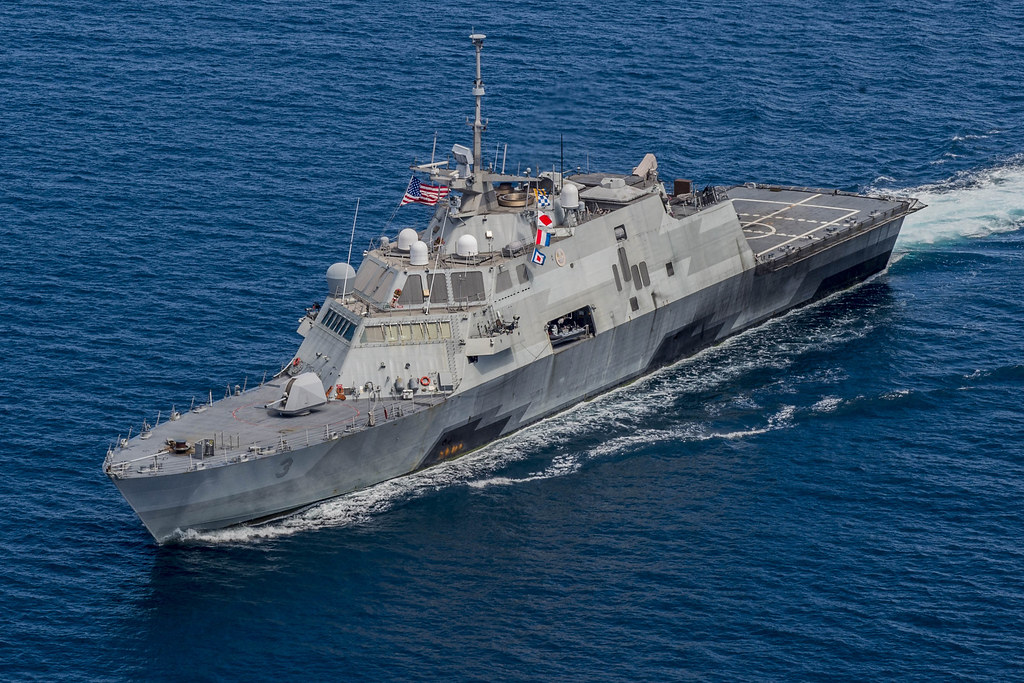By Lt. Kevin Chambers, Destroyer Squadron 7 Public Affairs
USS Fort Worth (LCS 3) operates in the Sulu Sea during exercise Cooperation Afloat Readiness and Training (CARAT) Malaysia in August.(U.S. Navy/MC2 Joe Bishop) >>
CHANGI NAVAL BASE, Singapore - USS Fort Worth (LCS 3) surpassed the one-year mark on her scheduled 16-month rotational deployment to Singapore in support of the Indo-Asia-Pacific rebalance Nov. 17.
As part of an initiative to deploy up to four LCS to the region on a rotational basis, Fort Worth deployed from San Diego on Nov. 17, 2014 and operates out of Singapore as a maintenance and logistics hub from which the ship conducts patrols and trains with regional navies during exercises like Cooperation Afloat Readiness and Training (CARAT).
"Fort Worth has demonstrated tremendous operational flexibility throughout her deployment," said Capt. H. B. Le, commodore, Destroyer Squadron 7. "She has operated in waters from Northeast Asia to the Indian Ocean, and her participation in multiple exercises with partner navies in South and Southeast Asia has greatly increased interoperability in the region."
The first LCS to deploy under the "3-2-1" manning concept, Fort Worth rotates fully trained crews roughly every four months. This concept allows Fort Worth to deploy six months longer than the 2013 USS Freedom (LCS 1) deployment and twice as long as typical U.S. Navy ship deployments, extending LCS forward presence and reducing crew fatigue for the entire 16-month deployment. It is named 3-2-1 because three rotational crews support two LCS ships and maintain one deployed ship.
Since arriving in Singapore Dec. 29, Fort Worth has participated in search efforts for AirAsia flight QZ8501; Naval Engagement Activity (NEA) Vietnam; exercise foal Eagle with the Republic of Korea Navy; CARAT exercises with Republic of the Philippines, Singapore, Indonesia, Malaysia, and Bangladesh; exercise Malabar with the Indian Navy and Japanese Maritime Self Defense Force (JMSDF); and conducted a routine patrol in the South China Sea near the Spratly Islands.
In addition to operations at sea, Fort Worth conducted her first-ever expeditionary maintenance availability in Sasebo, Japan following exercise Foal Eagle. The successful implementation of this expeditionary maintenance concept now means that LCS can operate at greater distances throughout the Indo-Asia-Pacific and can stay out for longer periods of time.
The ship also made tangible strides in enhancing interoperability with its composite rotary-wing air detachment, conducting first-time LCS deck landing qualifications with 6 different partner navies while operating the MQ-8B Fire Scout with the Republic of Singapore Navy scan eagle unmanned aerial vehicle during CARAT Singapore.
Fort Worth has operated the entirety of her deployment with a surface warfare mission package, consisting of an MH-60R helicopter, MQ-8B Fire Scout unmanned aircraft system, and two 11-meter rigid-hull inflatable boats (RHIBs) with two six-man boarding teams. This deployment marks the first time Fire Scout is operating in 7th Fleet onboard Fort Worth, expanding the ship’s aviation capabilities and providing a dedicated asset for maritime domain awareness.
Fast, agile and mission-focused, littoral combat ships are designed to operate in near-shore environments and employ modular mission packages that can be configured for surface warfare, mine countermeasures or anti-submarine warfare.
The U.S. 7th Fleet conducts forward-deployed naval operations in support of U.S. national interests in the Indo-Asia-Pacific area of operations. As the U.S. Navy's largest numbered fleet, U.S. 7th Fleet interacts with 35 other maritime nations to build partnerships that foster maritime security, promote stability and prevent conflict.

